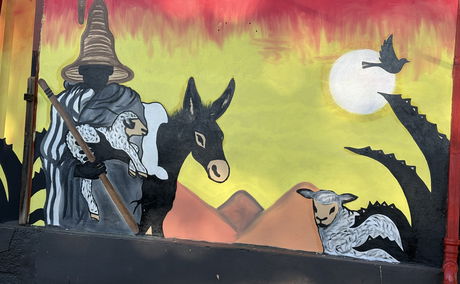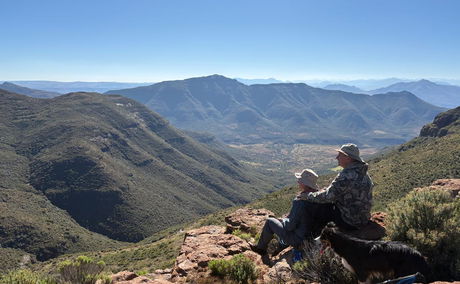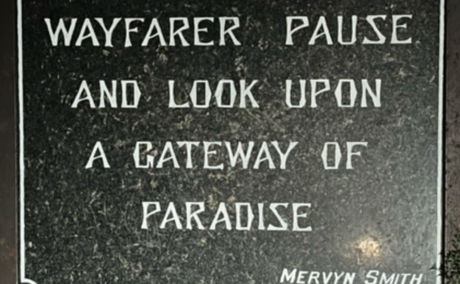Artist. Storyteller. Visionary My name is Majara, a 30-year-old Mosotho artist based in Ha Thetsane, Maseru. Art has been part of my life for as long as I can remember—more than just a passion, it’s how I see and connect with the world. I began studying Architectural Technology at Lerotholi Polytechnic, but unfortunately had to leave during my second year due to financial constraints. Still, that didn’t stop me. I continued to...
POPULAR SUPERSTITIONS, BELIEFS AND CUSTOMS by Justinus Sechefo Preface
The following is but a meagre account of the many superstitions, beliefs, customs and practices still common in the different parts of Basutoland. To enumerate them all would be impossible for this would require the help of many of the now unavailable grey heads to call them back to memory; since through the coming of the white man, the belief in Christianity, neglect and disuse, they are almost forgotten or even abused, while to the present generation many of the superstitions are entirely unknown.
However the in born spirit, traditions, influences and keen interest aroused by listening attentively to folk tales, fables, ghost and witchcraft stories told by grand mothers to their grandchildren at bed time in the hut; and also other peculiar talks among the men at home or in the "khotla" in the evenings about these beliefs and customs; all these I say must naturally have implanted in the minds of young listeners, deep and not to be shaken impressions about these customs and beliefs.In those days to have doubted the integrity of charms, the binding necessity of certain incisions, the magical powers of the "baloi" evil doers, witches and those of ghosts etc. would have deemed worse than insanity itself.
Poetical and rhymed amusing songs were sung, nursery tales repeated about these beliefs at the hearth by night, and fables were told at bed time by old grannies to their grandchildren, who in every case slept at their houses, in order to shun the abusive slander "ho hloba khoale" to pluck the partridge recklessly or in ordinary. "Do not pamper your children". Superstitions, fables and nursery tales were then and there related to the little ones. However it must be remembered that fables were not too be narrated during the day time, but only at night, these being a strong belief that a mysterious horn would happen too grow on the head of the person who encounted fables during the day time.
DEATH
Since death was considered so terrible an occurrence in all localities, it would be out of the question to classify the many inconvenient superstitions about it. In those olden times the "leqhofa" the hut of the dead man, especially one in which an aged person died, who had no family, was left unoccupied, its entrance blocked up either with stones or bundles of grass. Kraals in which such deaths occurred were deserted and the spots no longer held fit for habitation.
Surprising or sudden deaths, such as caused by the striking of lightning etc. were incidents of great shock. Witch doctors were urgently sought for, and divining bones thrown down by them to reveal the mournful secrets. Death reports were announced to relatives at night. Children upon their inquiring as to the whereabouts of such and such a newly deceased, were told, "ofaletse" he has emigrated, and not "o shoele" he is dead, which was a vulgar as well as a wrong saying.
It was also improper especially during the term of mourning to pronounce the name of the deceased, but he should be addressed "the late so and so".In olden times there was no night watch over the corpse as is done today, since as far as possible the corpse was buried during the night of the day of death.
Funerals were nocturnal performances, held only by grown ups at dead of night. In many cases the young were not allowed to see the dead body, neither to attend the funeral.
THE END OF THE HELPLESS OLD AGED
"A very old man who would not die", but was a nuisance and a burden to the family, was done away with. He would be placed at the entrance of the cattle kraal, so that the cattle getting inside the kraal for the night would trample him to death and then he would be picked up to be buried quietly.
GRAVES
On no account should the grave dug out for the dead remain open during the night. The corpse must necessarily be buried on the same day the grave was dug, that is on the day of death. But in the case of great stress or perplexity impeding the burial, the grave should be watched by men throughout the night to prevent the "baloi" (evil doers) from approaching it.
Graves of elders and owners of cattle were dug out in their cattle kraals since of necessity the rich should not be separated from their cattle.. The stones of the kraal were removed for sufficient space for the grave, and the kraal was built up again after the burial. The grave itself was nothing more than a round hole, a few feet deep, since there were no spades for digging, but only small iron rods called “kepa” used for digging medicines or clumsy blindly pointed sticks made from hard wood of the wild olive tree. The body was not laid stretched out in the graves, but was buried in a sitting position.
Visible graves, outside the village, were as far as possible avoided so as not to frighten people. In the case of those who had no reason to be buried in respectable graves in their cattle kraals and in the case of strangers, graves were dug outside the village. These unfortunate places were dreaded spots. People should not sit nor stand upon the heap of a grave. A person who happened unconsciously to do so, should have his or her feet passed slightly over a brisk fire of grass to scorch off the misfortune.
THE BURIAL
In those primitive days of feudal times, even in days of leisure and peace, men and boys did not sit down heavily on the ground. They always “satup” even in the “Khotla” while eating, so as to be able to leap up instantly at any call of alarm.
The dead body for interment was wound up in an ox skin, bound with ropes of the “moli grass” and placed “sitting up” in the grave, sop as to be able to rise up instantly on the day when it would be summoned to do so.
Under no circumstances should the corpse be buried lying stretched out in the grave. The corpse was gently lowered down into the grave and supported on all sides with the ground dug out to keep it firmly “sitting up”.
A few grains of the seeds of the “mabele”, occasionally maize, sugar cane, pumpkin seeds and a tuft of ordinary doog grass twisted into a tiny ring were thrown beside the body in the grave. His or her snuff box, if any, was also placed at the side of the body.
The corpse was placed sitting up in such a way as to half face the east, so that the rising sun might slightly cast its rays on the corpse’s right cheek. Some of the binding ropes about the head were gently cut through with a knife so that the covering of the face could be slightly opened to prevent suffocation. The ground was then thrown in as far as the level of the head. Lastly a small flat stone was placed directly above the centre of the head and the grave was filled up with sand.
In each case the ground dug out of the grave should all be brought back to fill it up again, so that none of it remained scattered about. The surroundings should be swept clean and all particles of earth remaining placed on the newly covered grave. However, should it happen that much of the ground remained, it was carefully removed and scattered thinly over the grass at some distance from the grave so as to prevent evil doers from taking any of it to do mischief over the corpse.
A mound of stones was built over the grave and a higher stone planted at the top end to mark the head side. In certain cases the dogs would smell out the putrified body which was not too deep in the ground and would scratch at the grave. In these cases it was necessary to crush the bitter roots of the “leshokhoa” plant, which were dipped in water and sprinkled over the grave, or placed in pans “mangetana”, around the grave.
An unfortunate man who died stretched out without people to help him to close his mouth and eyelids, or fold his arms and legs, had the stiff muscles at the back of the knee joint gently cut through with a knife, so as to allow the body to be easily positioned sitting up in the grave.
Now in modern times, since the heir is the first to let flow his blood at all incision ceremonies in the family, it is also hiss privilege to be the first to throw a handful or spadeful of soil into the grave. The rest of the family, beginning with the eldest, follows after him, after which everyone can then take part in filling up the grave.
The custom of the olden times was that the person who placed the corpse into the grave had to be purified or compensated as explained later. At the same time, this showed the public the lineage and succession of the family in case of any dispute afterwards.
An imposter, “ho ja metlakana”, who falsely claimed and took upon himself this exceptional privilage which did not lawfully belong to him, would be condemned by the ancestral gods. Invariably such a man became stupid, dull or even insane. The pan that bore the seeds in the grave was place above the grave.
EMBRYOS
Embryos are buried in old broken earthen pots. The smallest may even be placed in an old horn of an ox and then buried. Only women , who have acted as midwives during the confinement may perform the burial, which takes place in the early hours of the morning or about nightfall. The grave or hole is dug out by the woman on an ash hill outside the premises. A man, if needed, may help dig out the hole, but cannot attend the burial.
COMMON BELIEFS
A house spider should not be disturbed, it being the pillar that sustains the “back- bones” of the family.
A whirl-wind, whirling into a house, foretells the coming of a stranger. A whirlwind whirling one about should be spat upon to quell the misfortune it brings.
A dog howling ominously, “moola ke seotsa”, brings evil. It must at once be stopped or chased away.
A dog should not sit in front of people, especially in front of men with it’s back turned towards them. This portends sure evil. At once it must be chased away with contempt.
A visitor going on a long journey, when passing a certain place, (generally between tow hills) where there is a heap of small stones piled together, should pick up another stone alongside of the road, spit on it and throw it on the heap. This is an omen for good luck and good eating along the journey and at his destination. The common mountains of Sefikeng and Sefikaneng derived their names from such big heaps made there in olden times.
A person stooping to drink water a a spouting spring of water should before drinking appease the master below by generously throwing on the surface of the agitating water a tuft of green herbs, otherwise the restless water will erupt onto his face.
A cock clucking like a hen brings evil to the owner - it should be destroyed at once. The same applies to a hen crowing like a cock.
Pottery women should cease to mix up their clay, to form pots, or to bake pots after a death in the village has been announced. After this time all pot work cracks and spoils.
Men should not eat bread-scraps from the pot because doing so would cause their drawers, “tseha” to burst asunder.
MASIANOKE and KHOHO ea LIRA:
This bird, “masianoke”, the Heron or Hamerkop, seems closely connected with lightning. When the “Masianoke” alights in the village, it announces lightning in it. This bird should in no way be killed, nor should it’s nest be touched or disturbed.
KHOHO -ea-LIRA
This bird, “Koho-ea-Lira” or Dikkop, screeching near the village forewarns of the the same evils, therefore, it rouses the apprehensions and anxieties of all villagers.
LEPHAKA-TLALI
The “lephaka-tlali” is a spot seen on grass in the fields that has supposedly been scorched by lightning. Such a spot used to be dreaded and someone unconsciously passing over it, should when noticing it, have his or her feet passed over a flame of fire on the grass to escape misfortune.
THE MOKHOTLA
The “Mokhotla”, or black ibis bird, possess exceptional and wonderful charms. To obtain these from it, a device is used. A snare is laid in the nest of the bird to catch it’s young ones. When one is caught it should neither be killed nor removed from it’s snare, but left securely ensnared within it’s strings. The mother bird when returning home and finding her young one ensnared in this manner, places a drug on the snare, which will cause the strings to open. In this way she releases the captured one. The famous drug found on the snare should be removed and used as a medicinal charm. However, should one on the following morning find the drug on the snare and the captured bird still ensnared, he must take the drug away, leaving the little bird ensnared and continue to do so every morning, until at least he has found it gone and a fresh drug on his snare. This particular drug is the true one to be preserved.
THE INFANT CHILD
The birth announcement of the first-born child to its father is formal. A male neighbour goes to the place where the father of the child happens to be and by standing behind him unnoticed strikes him with a stick in his hand saying: “We are given a son!” In the case of a female child, a woman in the same way pours a calabash of water over his head saying: “The birth of a girl!”.
This shock and excitement changes into joy itself. The first-born boy is the property of the grand-parents. It has to be weaned by a ceremony performed by the grand-father, generally after the of two or even three years suckling, during which period there are no sexual relations between the young couples.
Such actions spoil the child, who at that time continues to suckle congealed milk, caused by pregnancy. The “senofu” or “spoiled child” suffers from chronic constipation, caused by the mild and very often dies.
So as to prevent an infant from afterwards becoming a rogue or a thief, it must be protected against the least rain drops for the space of two or three months after birth. Then on one fine day, when there will be a nice shower of rain, the infant is taken out and gently laid down on the ground in the reed closure in front of the house. Here pouring rain will freely spatter over it for a few moments. The frightened infant will scream bitterly. The family all shout out as if mocking at it, saying: “Ah! Behold the thief, the thief, the thief!” Suddenly it is picked up, wiped, caressed and taken to the house.
A young child ready to be given solid food, should be given it by a chosen man known to be of a good temper and morals. He gives it a slice of meat, which the child sucks eagerly as if it were sucking into itself the good qualities of the man. In the olden times, it was customary that a good respectable herd boy should exclusively do the milking of the cows for the infants.
All adults, men and women, with the exception of the aged and younger boys and girls are forbidden, for the space of two or three months after the confinement of a woman, to enter into her premises, since their “bad conduct and trampling everywhere”, they are apt to cause evil to the infant, “ho hata ngoana”.
Further Reading
Today we conquered the mighty Three Peaks – Mount Fuku Fuku and her two majestic sisters – on a truly unforgettable hike from Malealea Lodge. We began by driving about 6.5 km up the rugged mountain road before parking the car and starting our ascent with our wonderful guide, Khomo. Distance: 8.5 km Time: ±4.5 hours (including a lunch break, plenty of photo ops, and lots of “just-looking-at-the-view” pauses — definitely not...
More than a hundred years ago, in 1905, Mervyn came to live in Malealea. He quickly developed a deep love for the land and an even greater passion for road-making. Back then, there were no trucks, no graders—just spades, picks, and wheelbarrows and the community. In order to get building supplies to Malealea, Mervyn had to forge a road from the top of the mountain pass, which he lovingly named “The Gates...




Share This Post